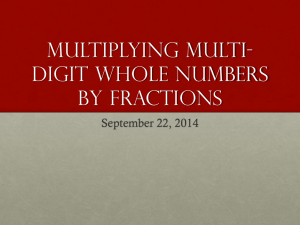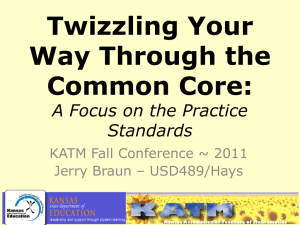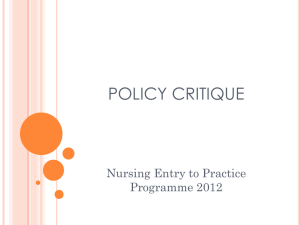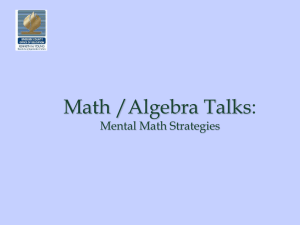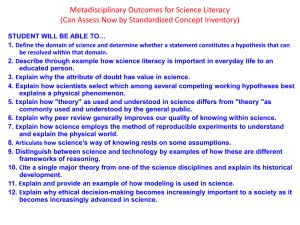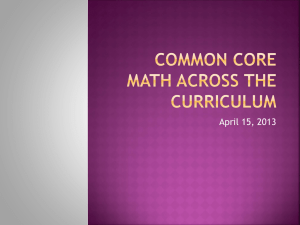Navigations Algebra
advertisement
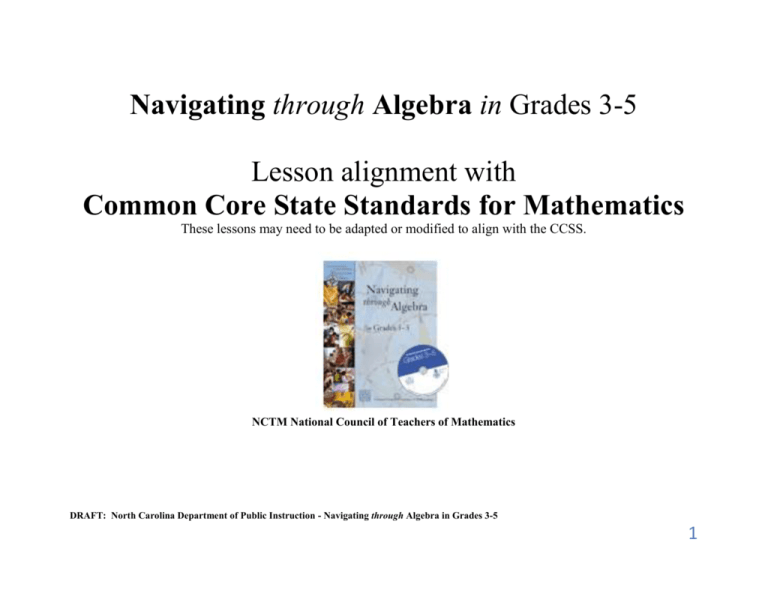
Navigating through Algebra in Grades 3-5 Lesson alignment with Common Core State Standards for Mathematics These lessons may need to be adapted or modified to align with the CCSS. NCTM National Council of Teachers of Mathematics DRAFT: North Carolina Department of Public Instruction - Navigating through Algebra in Grades 3-5 1 Navigating through Algebra in Grades 3-5 Lesson alignment with Common Core State Standards for Mathematics Chapter Lesson Title, Page Number and Goal Student Behaviors (Mathematical Practices) to Look For… CCSS Cluster/Standard Third Grade Chapter 1: Patterns Hundred-Board Wonders page 9 Goals: Given a rule, students will explore number patterns using a hundred board. Solve problems involving the four operations, and identify and explain patterns in arithmetic. 3.OA.9 Identify arithmetic patterns (including patterns in the addition table or multiplication table), and explain them using properties of operations. For example, observe that 4 times a number is always even, and explain why 4 times a number can be decomposed into two equal addends. This tasked could be modified for third by making the patterns for the students then have them identify the pattern. Chapter 2: Variables and Equations The Variable Machine page 39 Solve problems involving the four operations, and identify and explain patterns in arithmetic. 3.OA.8 Solve two-step word problems using the four operations. Represent these problems using equations with a letter standing for the unknown quantity. Assess the reasonableness of answers using mental computation and estimation strategies including rounding.3 Goals: The student will*explore the idea of variable as a symbol that can stand for any 3 This standard is limited to problems posed with whole numbers and having number of a set of numbers; *substitute numbers for variables whole-number answers; students should know how to perform operations in the conventional order when there are no parentheses to specify a particular (letters) to discover unknown order. values. Mathematical Practice focus is in bold: 1. Make sense of problems and persevere in solving them. 2. Reason abstractly and quantitatively. 3. Construct viable arguments and critique the reasoning of others. 4. Model with mathematics. 5. Use appropriate tools strategically. 6. Attend to precision. 7. Look for and make use of structure. 8. Look for and express regularity in repeated reasoning. Mathematical Practice focus is in bold: 1. Make sense of problems and persevere in solving them. 2. Reason abstractly and quantitatively. 3. Construct viable arguments and critique the reasoning of others. 4. Model with mathematics. 5. Use appropriate tools strategically. 6. Attend to precision. 7. Look for and make use of structure. 8. Look for and express regularity in repeated reasoning. DRAFT: North Carolina Department of Public Instruction - Navigating through Algebra in Grades 3-5 2 Chapter 2: Variables and Equations I Spy Patterns page 48 Goals: The student will*partition the given array into different parts; *translate visual patterns into numerical expressions; Explore how equivalent numerical expressions represent the commutative and associative properties of operations. Understand properties of multiplication and the relationship between multiplication and division. 3.OA.5 Apply properties of operations as strategies to multiply and divide.2 Examples: If 6 × 4 = 24 is known, then 4 × 6 = 24 is also known. (Commutative property of multiplication.) 3 × 5 × 2 can be found by 3 × 5 = 15, then 15 × 2 = 30, or by 5 × 2 = 10, then 3 × 10 = 30. (Associative property of multiplication.) Knowing that 8 × 5 = 40 and 8 × 2 = 16, one can find 8 × 7 as 8 × (5 + 2) = (8 × 5) + (8 × 2) = 40 + 16 = 56. (Distributive property.) 6. Understand division as an unknown-factor problem. For example, find 32 ÷ 8 by finding the number that makes 32 when multiplied by 8. 2 Chapter 3: Functions That’s Odd! page 61 Goals: The student will*observe various patterns in an array; *represent observed visual patterns as numerical patterns; *represent a numerical pattern as a functional relationship. Mathematical Practice focus is in bold: 1. Make sense of problems and persevere in solving them. 2. Reason abstractly and quantitatively. 3. Construct viable arguments and critique the reasoning of others. 4. Model with mathematics. 5. Use appropriate tools strategically. 6. Attend to precision. 7. Look for and make use of structure. 8. Look for and express regularity in repeated reasoning. Students need not use formal terms for these properties. Solve problems involving the four operations, and identify and explain patterns in arithmetic. 3.OA.9 Identify arithmetic patterns (including patterns in the addition table or multiplication table), and explain them using properties of operations. For example, observe that 4 times a number is always even, and explain why 4 times a number can be decomposed into two equal addends. (This lesson could be used in 3rd or 4th depending on focus.) Mathematical Practice focus is in bold: 1. Make sense of problems and persevere in solving them. 2. Reason abstractly and quantitatively. 3. Construct viable arguments and critique the reasoning of others. 4. Model with mathematics. 5. Use appropriate tools strategically. 6. Attend to precision. 7. Look for and make use of structure. 8. Look for and express regularity in repeated reasoning. DRAFT: North Carolina Department of Public Instruction - Navigating through Algebra in Grades 3-5 3 Fourth Grade Chapter 1: Patterns Hundred-Board Wonders page 9 Goals: Given a rule, students will explore number patterns using a hundred board. Chapter 1: Patterns Watch Them Grow page 12 Goals: Students will*observe patterns and relationships; *make conjectures about patterns and test those conjectures; *discuss verbalize, generalize, and represent patterns and relationships. Chapter 1: Patterns Calculator Patterns page 15 Goals: Students will*explore patterns using a Generate and analyze patterns. 4.OA.5 Generate a number or shape pattern that follows a given rule. Identify apparent features of the pattern that were not explicit in the rule itself. For example, given the rule “Add 3” and the starting number 1, generate terms in the resulting sequence and observe that the terms appear to alternate between odd and even numbers. Explain informally why the numbers will continue to alternate in this way. Generate and analyze patterns. 4.OA.5 Generate a number or shape pattern that follows a given rule. Identify apparent features of the pattern that were not explicit in the rule itself. For example, given the rule “Add 3” and the starting number 1, generate terms in the resulting sequence and observe that the terms appear to alternate between odd and even numbers. Explain informally why the numbers will continue to alternate in this way. Generate and analyze patterns. 4.OA.5 Generate a number or shape pattern that follows a given rule. Identify apparent features of the pattern that were not explicit in the rule itself. For example, given the rule “Add 3” and the starting number 1, generate terms in the resulting sequence and observe that Mathematical Practice focus is in bold: 1. Make sense of problems and persevere in solving them. 2. Reason abstractly and quantitatively. 3. Construct viable arguments and critique the reasoning of others. 4. Model with mathematics. 5. Use appropriate tools strategically. 6. Attend to precision. 7. Look for and make use of structure. 8. Look for and express regularity in repeated reasoning. Mathematical Practice focus is in bold: 1. Make sense of problems and persevere in solving them. 2. Reason abstractly and quantitatively. 3. Construct viable arguments and critique the reasoning of others. 4. Model with mathematics. 5. Use appropriate tools strategically. 6. Attend to precision. 7. Look for and make use of structure. 8. Look for and express regularity in repeated reasoning. Mathematical Practice focus is in bold: 1. Make sense of problems and persevere in solving them. 2. Reason abstractly and quantitatively. 3. Construct viable arguments and critique the reasoning of others. DRAFT: North Carolina Department of Public Instruction - Navigating through Algebra in Grades 3-5 4 calculator; *translate patterns into numerical patterns. the terms appear to alternate between odd and even numbers. Explain informally why the numbers will continue to alternate in this way. Chapter 2: Variables and Equations Catch of the Day! page 41 Goals: The student will*work with variables as they determine the number of each kind of fish caught; *record algebraically the statements of the results of their “catch.” Use the four operations with whole numbers to solve problems. 4.OA.3 Solve multistep word problems posed with whole numbers and having whole-number answers using the four operations, including problems in which remainders must be interpreted. Represent these problems using equations with a letter standing for the unknown quantity. Assess the reasonableness of answers using mental computation and estimation strategies including rounding. Chapter 2: Variables and Equations Building Houses page 51 Use the four operations with whole numbers to solve problems. 4.OA.3 Solve multistep word problems posed with whole numbers and having whole-number answers using the four operations, including problems in which remainders must be interpreted. Represent these problems using equations with a letter standing for the unknown quantity. Assess the reasonableness of answers using mental computation and estimation strategies including rounding. Goals: The student will*verbalize the numerical relationship in each problem; *translate each relation into an algebraic equation. Chapter 3: Functions Triangle-Rule Machine page 58 Generate and analyze patterns. 4.OA.5 Generate a number or shape pattern that follows a given rule. Identify apparent features of the pattern that were 4. Model with mathematics. 5. Use appropriate tools strategically. 6. Attend to precision. 7. Look for and make use of structure. 8. Look for and express regularity in repeated reasoning. Mathematical Practice focus is in bold: 1. Make sense of problems and persevere in solving them. 2. Reason abstractly and quantitatively. 3. Construct viable arguments and critique the reasoning of others. 4. Model with mathematics. 5. Use appropriate tools strategically. 6. Attend to precision. 7. Look for and make use of structure. 8. Look for and express regularity in repeated reasoning. Mathematical Practice focus is in bold: 1. Make sense of problems and persevere in solving them. 2. Reason abstractly and quantitatively. 3. Construct viable arguments and critique the reasoning of others. 4. Model with mathematics. 5. Use appropriate tools strategically. 6. Attend to precision. 7. Look for and make use of structure. 8. Look for and express regularity in repeated reasoning. Mathematical Practice focus is in bold: 1. Make sense of problems and persevere in solving them. DRAFT: North Carolina Department of Public Instruction - Navigating through Algebra in Grades 3-5 5 Goals: The student will*investigate the perimeter of figures composed of equilateral triangles arranged in a row; *describe (verbally and symbolically) the “rule,” or function, that will produce the perimeter for any given arrangement of triangles; *make a connection to the idea of function when describing the rule for a pattern with numbers. Chapter 3: Functions That’s Odd! page 61 Goals: The student will*observe various patterns in an array; *represent observed visual patterns as numerical patterns; *represent a numerical pattern as a functional relationship. Chapter 3: Functions Squares Cubes page 64 not explicit in the rule itself. For example, given the rule “Add 3” and the starting number 1, generate terms in the resulting sequence and observe that the terms appear to alternate between odd and even numbers. Explain informally why the numbers will continue to alternate in this way. Solve problems involving measurement and conversion of measurements from a larger unit to a smaller unit. 4.MD.3 Apply the area and perimeter formulas for rectangles in real world and mathematical problems. For example, find the width of a rectangular room given the area of the flooring and the length, by viewing the area formula as a multiplication equation with an unknown factor. This lesson uses triangles not rectangles as noted in standard so lesson could be used as an extension of standard or modify task and use rectangles. Generate and analyze patterns. 4.OA.5 Generate a number or shape pattern that follows a given rule. Identify apparent features of the pattern that were not explicit in the rule itself. For example, given the rule “Add 3” and the starting number 1, generate terms in the resulting sequence and observe that the terms appear to alternate between odd and even numbers. Explain informally why the numbers will continue to alternate in this way. (This lesson could be used in 3rd or 4th depending on focus.) Solve problems involving measurement and conversion of measurements from a larger unit to a smaller unit. 4.MD.3 Apply the area and perimeter formulas for rectangles in real world and mathematical problems. 2. Reason abstractly and quantitatively. 3. Construct viable arguments and critique the reasoning of others. 4. Model with mathematics. 5. Use appropriate tools strategically. 6. Attend to precision. 7. Look for and make use of structure. 8. Look for and express regularity in repeated reasoning. Mathematical Practice focus is in bold: 1. Make sense of problems and persevere in solving them. 2. Reason abstractly and quantitatively. 3. Construct viable arguments and critique the reasoning of others. 4. Model with mathematics. 5. Use appropriate tools strategically. 6. Attend to precision. 7. Look for and make use of structure. 8. Look for and express regularity in repeated reasoning. Mathematical Practice focus is in bold: 1. Make sense of problems and persevere in solving them. 2. Reason abstractly and quantitatively. DRAFT: North Carolina Department of Public Instruction - Navigating through Algebra in Grades 3-5 6 Goals: The student will*investigate the functional relationship between the length of the sides of a square and its perimeter and area; *describe the functional relationship between the length of the sides of a square and(a) their perimeters and the sides increase in length, (b) their areas as the sides increase in length; *describe the functional relationship between the length of the sides of cubes and their volumes as the sides increase in length. (5th Grade) For example, find the width of a rectangular room given the area of the flooring and the length, by viewing the area formula as a multiplication equation with an unknown factor. (This lesson could be used in 4th or 5th depending on focus.) 3. Construct viable arguments and critique the reasoning of others. 4. Model with mathematics. 5. Use appropriate tools strategically. 6. Attend to precision. 7. Look for and make use of structure. 8. Look for and express regularity in repeated reasoning. DRAFT: North Carolina Department of Public Instruction - Navigating through Algebra in Grades 3-5 7 Fifth Grade Chapter 1: Patterns Tiling a Patio page 18 Goals: Students will – *observe patterns and relationship; *make conjectures about patterns and test those conjectures; *discuss, verbalize, and represent patterns and relationships. Chapter 1: Patterns The Ups and Downs of Patterns page 27 Goals: The students will identify and analyze situations with constant or varying rates of change. Chapter 1: Patterns Graphic Stories page 31 Goals: The students will – Analyze patterns and relationships. 5.OA.3 Generate two numerical patterns using two given rules. Identify apparent relationships between corresponding terms. Form ordered pairs consisting of corresponding terms from the two patterns, and graph the ordered pairs on a coordinate plane. For example, given the rule “Add 3” and the starting number 0, and given the rule “Add 6” and the starting number 0, generate terms in the resulting sequences, and observe that the terms in one sequence are twice the corresponding terms in the other sequence. Explain informally why this is so. Mathematical Practice focus is in bold: 1. Make sense of problems and persevere in solving them. 2. Reason abstractly and quantitatively. 3. Construct viable arguments and critique the reasoning of others. 4. Model with mathematics. 5. Use appropriate tools strategically. 6. Attend to precision. 7. Look for and make use of structure. 8. Look for and express regularity in repeated reasoning. 5.OA.3 Generate two numerical patterns using two given rules. Identify apparent relationships between corresponding terms. Form ordered pairs consisting of corresponding terms from the two patterns, and graph the ordered pairs on a coordinate plane. For example, given the rule “Add 3” and the starting number 0, and given the rule “Add 6” and the starting number 0, generate terms in the resulting sequences, and observe that the terms in one sequence are twice the corresponding terms in the other sequence. Explain informally why this is so. Mathematical Practice focus is in bold: 1. Make sense of problems and persevere in solving them. 2. Reason abstractly and quantitatively. 3. Construct viable arguments and critique the reasoning of others. 4. Model with mathematics. 5. Use appropriate tools strategically. 6. Attend to precision. 7. Look for and make use of structure. 8. Look for and express regularity in repeated reasoning. 5.OA.3 Generate two numerical patterns using two given rules. Identify apparent relationships between corresponding terms. Form ordered pairs consisting of corresponding terms from the two patterns, and graph the ordered pairs on a coordinate plane. Mathematical Practice focus is in bold: 1. Make sense of problems and persevere in solving them. 2. Reason abstractly and quantitatively. 3. Construct viable arguments and critique the DRAFT: North Carolina Department of Public Instruction - Navigating through Algebra in Grades 3-5 8 *explore relationship between variables; *interpret relationship expressed in a line graph. For example, given the rule “Add 3” and the starting number 0, and given the rule “Add 6” and the starting number 0, generate terms in the resulting sequences, and observe that the terms in one sequence are twice the corresponding terms in the other sequence. Explain informally why this is so. Chapter 1: Patterns What’s the Best Deal? page 33 5.OA.3 Generate two numerical patterns using two given rules. Identify apparent relationships between corresponding terms. Form ordered pairs consisting of corresponding terms from the two patterns, and graph the ordered pairs on a coordinate plane. For example, given the rule “Add 3” and the starting number 0, and given the rule “Add 6” and the starting number 0, generate terms in the resulting sequences, and observe that the terms in one sequence are twice the corresponding terms in the other sequence. Explain informally why this is so. Goals: The student will – *create a table of values for a given pattern; *graph the given table of values; Discuss the shape of the graph (straight lines, curved lines) and what the graphs tell about the “growth: of the pattern (i.e., the function) Chapter 3: Functions Squares Cubes page 64 Goals: The student will*investigate the functional relationship between the length of the sides of a square and its perimeter and area; *describe the functional relationship between the length of the sides of a square and(a) their perimeters and the sides increase in length, Geometric measurement: understand concepts of volume and relate volume to multiplication and to addition. 5.MD.3 Recognize volume as an attribute of solid figures and understand concepts of volume measurement. a. A cube with side length 1 unit, called a “unit cube,” is said to have “one cubic unit” of volume, and can be used to measure volume. b. A solid figure which can be packed without gaps or overlaps using n unit cubes is said to have a volume of n cubic units. 5.MD.4 Measure volumes by counting unit cubes, using cubic cm, cubic in, cubic ft, and improvised units. 5.MD.5 Relate volume to the operations of multiplication and addition and solve real world and mathematical problems reasoning of others. 4. Model with mathematics. 5. Use appropriate tools strategically. 6. Attend to precision. 7. Look for and make use of structure. 8. Look for and express regularity in repeated reasoning. Mathematical Practice focus is in bold: 1. Make sense of problems and persevere in solving them. 2. Reason abstractly and quantitatively. 3. Construct viable arguments and critique the reasoning of others. 4. Model with mathematics. 5. Use appropriate tools strategically. 6. Attend to precision. 7. Look for and make use of structure. 8. Look for and express regularity in repeated reasoning. Mathematical Practice focus is in bold: 1. Make sense of problems and persevere in solving them. 2. Reason abstractly and quantitatively. 3. Construct viable arguments and critique the reasoning of others. 4. Model with mathematics. 5. Use appropriate tools strategically. 6. Attend to precision. 7. Look for and make use of structure. 8. Look for and express regularity in repeated reasoning. DRAFT: North Carolina Department of Public Instruction - Navigating through Algebra in Grades 3-5 9 (b) their areas as the sides increase in length; *describe the functional relationship between the length of the sides of cubes and their volumes as the sides increase in length. (5th Grade) involving volume. a. Find the volume of a right rectangular prism with wholenumber side lengths by packing it with unit cubes, and show that the volume is the same as would be found by multiplying the edge lengths, equivalently by multiplying the height by the area of the base. Represent threefold whole-number products as volumes, e.g., to represent the associative property of multiplication. b. Apply the formulas V = l × w × h and V = b × h for rectangular prisms to find volumes of right rectangular prisms with whole-number edge lengths in the context of solving real world and mathematical problems. c. Recognize volume as additive. Find volumes of solid figures composed of two non-overlapping right rectangular prisms by adding the volumes of the nonoverlapping parts, applying this technique to solve real world problems. (This lesson could be used in 4th or 5th depending on focus.) DRAFT: North Carolina Department of Public Instruction - Navigating through Algebra in Grades 3-5 10

